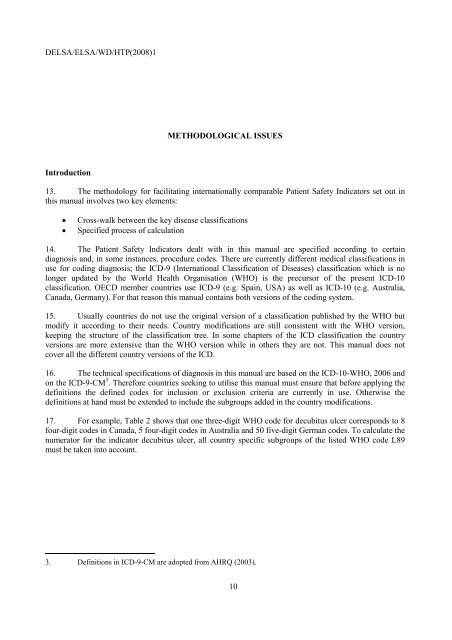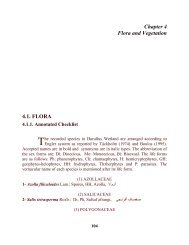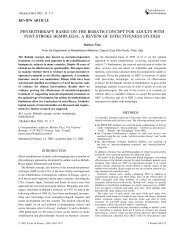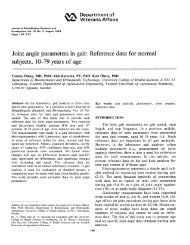- Page 1 and 2: DELSA/ELSA/WD/HTP(2008)1FACILITATIN
- Page 3 and 4: DELSA/ELSA/WD/HTP(2008)1DIRECTORATE
- Page 5 and 6: DELSA/ELSA/WD/HTP(2008)1SUMMARYThis
- Page 7 and 8: DELSA/ELSA/WD/HTP(2008)1TABLE OF CO
- Page 9: DELSA/ELSA/WD/HTP(2008)15. The conf
- Page 13 and 14: DELSA/ELSA/WD/HTP(2008)1Cross Walki
- Page 15 and 16: DELSA/ELSA/WD/HTP(2008)137. There a
- Page 17 and 18: DELSA/ELSA/WD/HTP(2008)1Quick Step
- Page 20 and 21: DELSA/ELSA/WD/HTP(2008)1DETAILED DE
- Page 22 and 23: 21DELSA/ELSA/WD/HTP(2008)1
- Page 24 and 25: DELSA/ELSA/WD/HTP(2008)1Case is a s
- Page 26 and 27: DELSA/ELSA/WD/HTP(2008)1Denominator
- Page 28 and 29: DELSA/ELSA/WD/HTP(2008)1Iatrogenic
- Page 30: DELSA/ELSA/WD/HTP(2008)1Case is a s
- Page 35 and 36: DELSA/ELSA/WD/HTP(2008)1Postoperati
- Page 37: DELSA/ELSA/WD/HTP(2008)1Postoperati
- Page 40 and 41: DELSA/ELSA/WD/HTP(2008)1Postoperati
- Page 42 and 43: DELSA/ELSA/WD/HTP(2008)1Case is a s
- Page 44 and 45: DELSA/ELSA/WD/HTP(2008)1Denominator
- Page 46 and 47: DELSA/ELSA/WD/HTP(2008)1Case is a s
- Page 48 and 49: DELSA/ELSA/WD/HTP(2008)1Exclude inf
- Page 50 and 51: DELSA/ELSA/WD/HTP(2008)1Obstetric T
- Page 52 and 53: DELSA/ELSA/WD/HTP(2008)1Obstetric t
- Page 54 and 55: DELSA/ELSA/WD/HTP(2008)1ICD-10-WHO
- Page 56 and 57: DELSA/ELSA/WD/HTP(2008)1Obstetric T
- Page 58 and 59: DELSA/ELSA/WD/HTP(2008)1ANNEX 1: DE
- Page 60 and 61:
DELSA/ELSA/WD/HTP(2008)1C-1: ICD-9-
- Page 62 and 63:
DELSA/ELSA/WD/HTP(2008)1C-2: ICD-9-
- Page 64 and 65:
DELSA/ELSA/WD/HTP(2008)1C-3: ICD-9-
- Page 66 and 67:
DELSA/ELSA/WD/HTP(2008)1Suicide and
- Page 68 and 69:
DELSA/ELSA/WD/HTP(2008)1C-8: ICD-9-
- Page 70 and 71:
DELSA/ELSA/WD/HTP(2008)1ICD-9-CM Tr
- Page 72 and 73:
DELSA/ELSA/WD/HTP(2008)1ICD-9-CM Po
- Page 74 and 75:
DELSA/ELSA/WD/HTP(2008)1C-10: ICD-9
- Page 76 and 77:
DELSA/ELSA/WD/HTP(2008)1C-10: ICD-9
- Page 78 and 79:
DELSA/ELSA/WD/HTP(2008)1C-10: ICD-9
- Page 80 and 81:
DELSA/ELSA/WD/HTP(2008)1C-10: ICD-9
- Page 82 and 83:
DELSA/ELSA/WD/HTP(2008)1C-13: ICD-9
- Page 84 and 85:
DELSA/ELSA/WD/HTP(2008)1C-17: ICD-1
- Page 86 and 87:
DELSA/ELSA/WD/HTP(2008)1Code List W
- Page 88 and 89:
DELSA/ELSA/WD/HTP(2008)1W-1: ICD-10
- Page 90 and 91:
DELSA/ELSA/WD/HTP(2008)1W-2 ICD-10-
- Page 92 and 93:
DELSA/ELSA/WD/HTP(2008)1W-2 ICD-10-
- Page 94 and 95:
DELSA/ELSA/WD/HTP(2008)1W-2 ICD-10-
- Page 96 and 97:
DELSA/ELSA/WD/HTP(2008)1W-2 ICD-10-
- Page 98 and 99:
DELSA/ELSA/WD/HTP(2008)1W-2 ICD-10-
- Page 100 and 101:
DELSA/ELSA/WD/HTP(2008)1W-3 ICD-10-
- Page 102 and 103:
DELSA/ELSA/WD/HTP(2008)1W-6: Poison
- Page 104 and 105:
DELSA/ELSA/WD/HTP(2008)1W-7: ICD-10
- Page 106 and 107:
DELSA/ELSA/WD/HTP(2008)1W-8: ICD-10
- Page 108 and 109:
DELSA/ELSA/WD/HTP(2008)1W-8: ICD-10
- Page 110 and 111:
DELSA/ELSA/WD/HTP(2008)1W-8: ICD-10
- Page 112 and 113:
DELSA/ELSA/WD/HTP(2008)1W-8: ICD-10
- Page 114 and 115:
DELSA/ELSA/WD/HTP(2008)1W-8: ICD-10
- Page 116 and 117:
DELSA/ELSA/WD/HTP(2008)1W-8: ICD-10
- Page 118 and 119:
DELSA/ELSA/WD/HTP(2008)1W-8: ICD-10
- Page 120 and 121:
DELSA/ELSA/WD/HTP(2008)1W-8: ICD-10
- Page 122 and 123:
DELSA/ELSA/WD/HTP(2008)1W-8: ICD-10
- Page 124 and 125:
DELSA/ELSA/WD/HTP(2008)1W-8: ICD-10
- Page 126 and 127:
DELSA/ELSA/WD/HTP(2008)1W-8: ICD-10
- Page 128 and 129:
DELSA/ELSA/WD/HTP(2008)1W-8: ICD-10
- Page 130 and 131:
DELSA/ELSA/WD/HTP(2008)1W-9:ICD-10-
- Page 132 and 133:
DELSA/ELSA/WD/HTP(2008)1W-10: ICD-1
- Page 134 and 135:
DELSA/ELSA/WD/HTP(2008)1W-10: ICD-1
- Page 136 and 137:
DELSA/ELSA/WD/HTP(2008)1W-10: ICD-1
- Page 138 and 139:
DELSA/ELSA/WD/HTP(2008)1W-10: ICD-1
- Page 140 and 141:
DELSA/ELSA/WD/HTP(2008)1W-10: ICD-1
- Page 142 and 143:
DELSA/ELSA/WD/HTP(2008)1W-10: ICD-1
- Page 144 and 145:
DELSA/ELSA/WD/HTP(2008)1W-17 ICD-10
- Page 146 and 147:
DELSA/ELSA/WD/HTP(2008)1Code List P
- Page 148 and 149:
DELSA/ELSA/WD/HTP(2008)1Operations
- Page 150 and 151:
DELSA/ELSA/WD/HTP(2008)1ICD-9-CM Ca
- Page 152 and 153:
DELSA/ELSA/WD/HTP(2008)1M-1 Code li
- Page 154 and 155:
DELSA/ELSA/WD/HTP(2008)1ICD-10WHOTi
- Page 156 and 157:
DELSA/ELSA/WD/HTP(2008)1ICD-10WHOTi
- Page 158 and 159:
DELSA/ELSA/WD/HTP(2008)1ICD-10WHOTi
- Page 160 and 161:
DELSA/ELSA/WD/HTP(2008)1ICD-10WHOTi
- Page 162 and 163:
DELSA/ELSA/WD/HTP(2008)1ICD-10WHOTi
- Page 164 and 165:
DELSA/ELSA/WD/HTP(2008)1ICD-10WHOTi
- Page 166 and 167:
DELSA/ELSA/WD/HTP(2008)1ICD-10WHOTi
- Page 168 and 169:
DELSA/ELSA/WD/HTP(2008)1ICD-10WHOTi
- Page 170 and 171:
DELSA/ELSA/WD/HTP(2008)1ICD-10WHOTi
- Page 172 and 173:
DELSA/ELSA/WD/HTP(2008)1ICD-10WHOTi
- Page 174 and 175:
DELSA/ELSA/WD/HTP(2008)1M-2 Code li
- Page 176 and 177:
DELSA/ELSA/WD/HTP(2008)1ICD-10WHOTi
- Page 178 and 179:
DELSA/ELSA/WD/HTP(2008)1ICD-10WHOTi
- Page 180 and 181:
DELSA/ELSA/WD/HTP(2008)1ICD-10WHOTi
- Page 182 and 183:
DELSA/ELSA/WD/HTP(2008)1ICD-10WHOTi
- Page 184 and 185:
DELSA/ELSA/WD/HTP(2008)1ICD-10WHOTi
- Page 186 and 187:
DELSA/ELSA/WD/HTP(2008)1ICD-10WHOTi
- Page 188 and 189:
DELSA/ELSA/WD/HTP(2008)1ICD-10WHOTi
- Page 190 and 191:
DELSA/ELSA/WD/HTP(2008)1ICD-10WHOTi
- Page 192 and 193:
DELSA/ELSA/WD/HTP(2008)1ICD-10WHOTi
- Page 194 and 195:
DELSA/ELSA/WD/HTP(2008)1ICD-10WHOTi
- Page 196 and 197:
DELSA/ELSA/WD/HTP(2008)1ICD-10WHOTi
- Page 198 and 199:
DELSA/ELSA/WD/HTP(2008)1ICD-10WHOTi
- Page 200 and 201:
DELSA/ELSA/WD/HTP(2008)1M-4 Code li
- Page 202 and 203:
DELSA/ELSA/WD/HTP(2008)1ICD-10WHOTi
- Page 204 and 205:
DELSA/ELSA/WD/HTP(2008)1ICD-10WHOTi
- Page 206 and 207:
DELSA/ELSA/WD/HTP(2008)1ICD-10WHOTi
- Page 208 and 209:
DELSA/ELSA/WD/HTP(2008)1ICD-10WHOTi
- Page 210 and 211:
DELSA/ELSA/WD/HTP(2008)1ICD-10WHOTi
- Page 212 and 213:
DELSA/ELSA/WD/HTP(2008)1ICD-10WHOTi
- Page 214 and 215:
DELSA/ELSA/WD/HTP(2008)1M-6 Code li
- Page 216 and 217:
DELSA/ELSA/WD/HTP(2008)1ICD-10WHOTi
- Page 218 and 219:
DELSA/ELSA/WD/HTP(2008)1ICD-10WHOTi
- Page 220 and 221:
DELSA/ELSA/WD/HTP(2008)1ICD-10WHOTi
- Page 222 and 223:
DELSA/ELSA/WD/HTP(2008)1ICD-10WHOTi
- Page 224 and 225:
DELSA/ELSA/WD/HTP(2008)1ANNEX 3: IN
- Page 226 and 227:
DELSA/ELSA/WD/HTP(2008)1III. Detail
- Page 228 and 229:
DELSA/ELSA/WD/HTP(2008)1IV. Details
- Page 230 and 231:
DELSA/ELSA/WD/HTP(2008)125 Psychatr
- Page 232 and 233:
DELSA/ELSA/WD/HTP(2008)1OECD Patien
- Page 234 and 235:
DELSA/ELSA/WD/HTP(2008)1Section IX
- Page 236 and 237:
Section XI Iatr PneumothoraxDELSA/E
- Page 238 and 239:
DELSA/ELSA/WD/HTP(2008)1Section XII
- Page 240 and 241:
DELSA/ELSA/WD/HTP(2008)1OECD (2007)










![Successful Ministry to the Retarded[ETowns] - Elmer Towns](https://img.yumpu.com/47721906/1/190x252/successful-ministry-to-the-retardedetowns-elmer-towns.jpg?quality=85)





